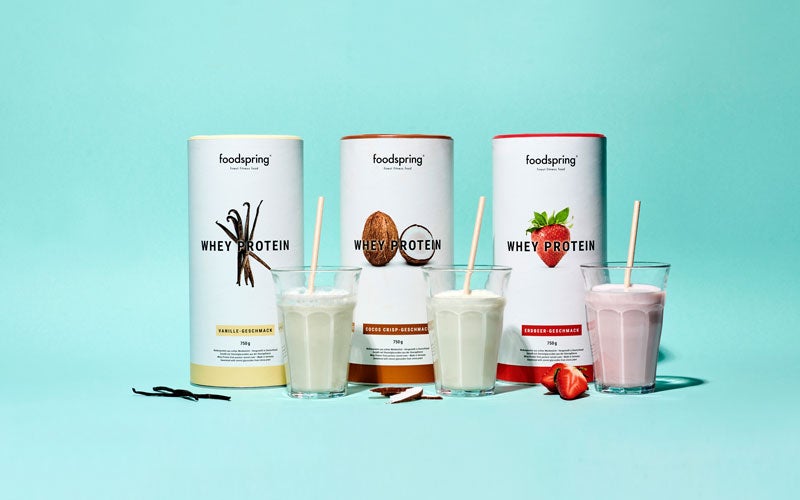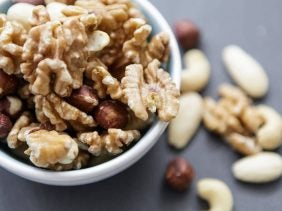Low-Carb Nutrition Plan: Lose weight with low-carb!
 ©foodspring
©foodspring
A low-carb nutrition plan can help you lose body fat quickly and can also be a useful tool in changing your diet long-term. A low-carb diet is suitable for anyone who wants to reduce body fat and define their muscles. A low-carb diet can help you lose weight and also build muscle mass.
We’ll show you what foods are suitable for a low-carb nutrition plan, why you don’t have to completely go without bread and what alternatives there are to potatoes etc. All you need to do is go through with our low-carb example day and adhere to our 8 basic rules when creating your low-carb nutrition plan.
Why Low-Carb – The Benefits
Along with fat, “carbs” (carbohydrates) are our main source of energy. In a low-carb nutrition plan, carbohydrates are deliberately reduced in order to lose body fat. Carbohydrates have a major impact on body fat percentage: When the body receives more carbohydrates than it needs, it stores the excess carbohydrates as fat reserves for emergencies.
Low-carb nutrition plans simply avoid carbohydrates, especially simple carbohydrates from white flour products and sugar. These products cause insulin levels to skyrocket, get in the way of fat burning and promote the storage of that surplus energy as body fat.
By consuming less carbs, insulin levels remain at a constant low, allowing the body to gain energy from fat. Three-to-five-hour breaks between meals additionally improve your fat metabolism.
The Benefits of a Low-Carb Diet
- Optimisation of the macro nutrient balance
- Stabilisation of blood sugar levels
- Rapid loss of body fat
A low-carb nutrition plan is therefore suitable for anyone who wants to reduce body fat. It can help you lose weight and can help bodybuilders define muscle.
Preliminary Considerations for a Low-Carb Nutrition Plan
The first step in creating a nutrition plan is defining your goal. Defining your goal is essential to achieving success.
- Do you want to quickly lose a few kilosto look good for your next competition or beach holiday? Then adhering to a strict low-carb nutrition plan is paramount. That also means avoiding all forms of grain and only eating vegetables with the lowest carbohydrate content.
Additional cardio workouts and a daily calorie deficit of about 300-400 kcal are also recommended. Quickly returning to a normal diet, however, is guaranteed to bring on the yoyo effect. Instead, you need to slowly increase your carbohydrate consumption and total calories again after the diet.
- If your goal is a long-term change in dietor optimizing your fat metabolism, it is worth making a low-carb nutrition plan that fits in with your personal eating habits and lifestyle. That means considering which foods you cannot live without and what your eating rhythm throughout the day is like, before creating your low-carb diet plan.
- Is going without bread a long-term option for you? If not, what low-carb alternatives satisfy in terms of taste and work in everyday life?
Low-Carb Nutrition Plan – 8 Basic Rules
1. Stay Hydrated
Water is essential to all metabolic processes in our body and prevents cravings. It is not uncommon for the brain to send the “hungry” signal when it’s actually in need of water.
2. Get Enough Protein
Proteins are filling and particularly important for building and maintaining muscle. Supplying the muscles with sufficient protein to protect them from breakdown is especially important when you’re on a calorie-reduced diet. The rule of thumb is 0.9 – 2g of protein per kg of body weight, depending on how much exercise is on the agenda and how much muscle mass you intend to gain. If you fail to meet your daily needs with the food you eat, protein shakes make a useful low-carb supplement.

For: Delicious shakes loaded with protein
Special Properties: Super-filling
When: Whenever you feel like a shake!
3. Healthy Fats
Healthy fats are filling and help prevent food cravings. Coconut oil is particularly impressive, packed full of medium-chain fatty acids (MCTs), which supply the body with directly available as well as long-lasting energy.
4. Avoid Snacking
All snacks – even tea with honey, white coffee, apple juice and healthy coconut water – increase blood sugar levels, make it difficult to burn fat and promote food cravings. That’s why it makes sense to give the body 3-5 hours between meals to digest uninterrupted.
5. Find Your Rhythm
When does your day begin? When do you relax, when do you exercise? Your eating pattern depends on all these factors. In order to be successful and to eat regularly, you need to consider all these factors when creating a low-carb nutrition plan. Your plan may consist of 3 or 5 meals a day – depending on these factors and on your individual preference.
6. Plan Your Meals
Out and about. Hunger strikes. Nothing to eat. Grab a sandwich. Back to low-carb tomorrow. This doesn’t have to happen: Cook ahead and pack crudités or vegetables in your bag as emergency snacks. You can get your hands on low-carb meals and snacks when you’re out and about as well.
7. Exercise Discipline in the Evening
The fat metabolism and regenerative processes in the body are especially active at night. Support your body by avoiding carbohydrates in the evening. This allows it to concentrate fully on repairing muscle and drawing on energy from the fat deposits.
8. Healthy Fats
Healthy fats fill you up and help you avoid stress cravings. Coconut oil is a special partner in this regard because of its medium-chain triglycerides (MCTs), which are easy for the body to utilize and deliver long-term energy. Another important benefit: coconut oil is very heat-resistant, making it a great option for cooking!
9. Allow for Setbacks
It’s impossible not to eat the odd sandwich or something sweet isn’t it? If you’re working on a long-term diet change you can give in to these cravings now and then. But there are alternatives. Valuable foods with long-chain carbohydrates are the alternative to white flour and sugar. Raw chocolate can help those with a sweet tooth. Most raw chocolate is sweetened with just a little coconut sugar and is available at all organic supermarkets.
Low-Carb Nutrition Plan – Foods
Our diets are often very carbohydrate heavy. It’s not just bread and pasta that contain carbohydrates. Even healthy foods like vegetables and fruits have varying levels of carbohydrates. Strict low-carb diet concepts often avoid fruit and vegetables (almost) entirely.
However, these diets are not healthy or feasible to keep up long-term. That’s why we are going to concentrate on a low-carb nutrition plan that can be designed according to your own personal preferences and that fits in with your everyday life. For those, who like to keep it simple and successful.
Low-carb alternatives to bread, etc.
Generally speaking, it is important to focus on vegetables and protein products when choosing your food. Since there are already enough carbohydrates contained in vegetables, you should generally avoid the common carbohydrates like bread, pasta etc. when on a low-carb diet.
If you don’t want to give up on your filling side dishes, you can fall back on small amounts quinoa or legumes such as chickpeas or beans. These have a much lower carbohydrate content than cereals and classic pseudo-cereals like amaranth and buckwheat. However, they still contain considerably more carbs than most vegetables. and people who choose to persist with these filling side dishes will have to wait longer to see results than those who don’t.
If you love bread and can’t cut it out of your diet, it’s no problem! You can eat your fill of our fluffy Protein Bread without feeling bad about it. Flax seeds, almonds, psyllium, and pumpkin seeds deliver a heaping helping of superpower through foods.

learn more about our protein bread
| High carbohydrate content | Alternatives |
| Pasta | Courgetti (zoodles), shirataki noodles |
| Rice | Grated parsnips |
| Wheat/rye/spelt bread | Chia/almond/soya bread |
| Muesli/oatmeal | Chia seeds or soya flakes |
| Potatoes | Cauliflower |
| Cashew nuts | Walnuts |
| Dried fruits | Vegetable chips |
Even vegetables contain varying levels of carbs. Mushrooms, cabbage, lettuce, dark green leafy vegetables, courgette, celery, green beans, tomatoes, olives, and peppers are ideal for a low-carb diet. Generally speaking, however, all vegetables are low in carbs compared to cereals and potatoes and should be included in your nutrition plan because of their health benefits.
There are important differences when it comes to fruit. While bananas have a lot of carbohydrates, blueberries, blackberries and oranges are relatively low in carbs. Apples, pears, currants and figs are somewhere in the middle. Dried fruit should generally be avoided. Even unsweetened, dried fruit often contains three to five times more sugar than fresh fruit.

©istock/ilmoro100
Low Carb Example Day
Breakfast
- Chia pudding with almond butter, blueberries and cinnamon
- If you’re really hungry: Add a protein shake with wild berries on the side
- If you prefer savory: Eggs and bacon. (On low-carb bread, of course!)
Lunch
- Zucchini noodles with mushrooms and pomegranate seeds
Dessert/Sweet snack
For one serving simply mix two small ripe avocados with 5 tablespoons of unsweetened cocoa powder and 1-2 teaspoons of coconut sugar
For an extra protein boost: Add 30 g Protein and 50 ml water
Evening
- Lamb’s lettuce or kale salad with beetroot, walnuts and sesame seeds
- Chicken breast or natural tofu
- Dressing: Walnut or sesame oil with balsamic vinegar and fresh herbs to taste
We also give you the option of using precise templates to create your own diet plan.
Download your free nutrition plan
Tips for Vegetarians and Allergy Sufferers:
Vegetarians and people with lactose intolerance in particular are advised to supplement their low-carb nutrition plan with protein shakes.
Generally speaking, a vegetarian diet can successfully cover the average person’s protein requirements. However, the fat content often becomes too high for a low-carb diet. Nuts, tofu, avocado and other low-carb plant protein sources are often relatively fatty. For the good of a balanced diet, vegetarians shouldn’t rely too heavily on dairy products.
Our Vegan Protein is rich in essential amino acids and ideal for vegan athletes. Learn more here:
Low-Carb Breakfast Recipes
Most of the concerns surrounding low-carb nutrition plans involve breakfast. Muesli, cornflakes, bread, rolls, bananas, chocolate spread – pure carbohydrates. The solution is to make some smart swaps to completely or partially replace classic breakfasts.
Chia Pudding Instead of Muesli
Enriched with almond butter or protein powder, chia pudding replaces carbohydrates with high-quality proteins and fats, letting you feel full for longer, rather than increasing your insulin levels.
Soy Flakes
Vegan soy flakes can be used like oatmeal and have a better ratio of protein to carbohydrates. Chia flour, almond flour, or soy flour can be used to replace part of the flour normally used in bread with protein. Topped with salmon or avocado, the low-carb breakfast is perfected and the hunger for carbohydrates is laid to rest.
With our low-carb recipes, conjuring up tasty dishes is quick and easy.
Alternatives to Chocolate Spread
If you don’t want to do without jam, you can always go for fresh fruit. But be careful: The carbohydrate content in fruit is relatively high. Home-made chocolate mousse with avocado and cocoa is a good alternative to Nutella.
Our tip for very special success moments? Workout and nutrition tips tailored to your needs and your goals. Our free Body Check calculates your BMI and offers tips and recommendations from our experts.
Sources for this article
We at foodspring use only high-quality sources, including peer-reviewed studies, to support the facts within our articles. Read our editorial policy to learn more about how we fact-check and keep our content accurate, reliable, and trustworthy.





























